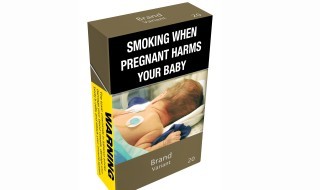 A new law on ‘plain’ cigarette packages is coming in on Friday, which will see an end to white packs with company logos in the UK.
A new law on ‘plain’ cigarette packages is coming in on Friday, which will see an end to white packs with company logos in the UK.
Under the new regulations, all tobacco packaging must be uniformly olive green and with large images intended to act as health warnings, while hand-rolled tobacco must be in the same colour and contain a minimum of 30g of tobacco.
Cigarettes and other tobacco products on sale in the UK must comply with the new regulations by May 2017.
The new law comes into effect at the same time as the revised European Union Tobacco Products Directive, which has banned packs of 10 cigarettes, as well as promotional statements, such as ‘this product is free of additives’ or ‘is less harmful than other brands’.
The new tobacco advertising rules also state that picture health warnings must cover 65% of the front and back of every packet of cigarettes, with additional warnings on the top.
Menthol cigarettes and slim ‘lipstick-style’ cigarettes are set to be banned in the UK by 2020. There will also be new rules on the amount and strength of liquid allowed in e-cigarettes and herbal products.
Smoking and dentistry
The British Dental Association (BDA) has welcomed the new law standardising tobacco packaging in the UK.
The BDA has campaigned vigorously for action on plain packs, and is a member of the Smokefree Action Coalition and a supporter of Action on Smoking and Health (ASH).
Tobacco use remains a key cause of gum disease and oral cancer, with treatment costing the taxpayer millions a year.
The BDA’s scientific adviser, Professor Damien Walmsley, said: ‘Action on plain packs is great news for the future of Britain’s oral health. As dentists, we see the impact of tobacco marketing on a daily basis, in patients with gum disease and oral cancer that often could have been prevented.
‘Distinctive packaging remains one of the tobacco industry’s top promotional tools, so there was never any excuse for delaying this initiative.
‘In Australia the evidence shows that plains packs are already helping make smoking less attractive. Taking the sheen off tobacco is an essential step to helping smokers break the habit, and preventing the next generation reaching for their first cigarette.’

CEO of the Oral Health Foundation, Dr Nigel Carter OBE, also welcomed the news, stating: ‘This is a very important and long overdue step that will hopefully bring about improvements in oral health and a reduction in the number of mouth cancer cases in the UK.
‘We have often criticised the government on its lack of movement on this issue and I am delighted that we have finally seen them make this decisive and important step which could save countless lives.
‘Smoking can cause a variety of oral health problems including tooth staining, dental plaque, bad breath, tooth loss and gum disease. Of more concern is the significant risk of developing life-threatening diseases such as lung disease and mouth cancer.
‘Tobacco remains the largest risk factor for mouth cancer, a disease that has increased by around a third in the last decade alone. Last numbers show there are more than 7,300 cases and 2,000 deaths each year from mouth cancer.
‘This move will hopefully make cigarettes far more unappealing and be a huge step in the right direction to start reducing those appalling figures.’
Breaking brand loyalty
Barbara Harpham, national director of charity Heart Research UK, welcomes the news that cigarettes are to be sold in plain packaging and that steps are being taken to increase the cost of a packet of cigarettes by increasing the minimum number sold as well as the longer-term plans to remove menthol cigarettes from sale.
‘As a charity, Heart Research UK support steps that discourage smoking, so the removal of branding on packaging and moving to plain packaging, to break brand loyalty has to be a good thing.
‘An estimated 10 million people still smoke and 200,000 11-15 year olds start smoking each year. So if we can discourage children from smoking by moving to plain packaging, increasing the cost of buying a packet of cigarettes, that will be the best thing. Cigarettes are addictive, so this is just another piece in the jigsaw to discourage people, including children from starting. If you don’t start smoking in the first place, you won’t become addicted.
‘For those who are still smoking, stopping can cut your risk of developing heart disease by 50%.’
Cigarettes and oral heath
- According to Cancer Research UK, an estimated 65% (70% in males and 55% in females) of oral and pharyngeal cancers in the UK are linked to tobacco smoking
- Oral cavity cancer risk is three times higher in current smokers compared with those who have never smoked, a meta-analysis showed
- ASH has estimated that a smoker has between a five-fold and 20-fold increased risk of periodontal (or gum) disease
- Smokers also exhibit higher rates of other oral diseases, including: alveolar (jaw) bone loss and tooth loss, oral infections, discolouration of teeth and oral tissues
- The BDA strongly supports the conclusions of the Chantler Review into standardised packaging of tobacco. We agree that the introduction of standardised packaging is likely to contribute to important public health gains, in conjunction with other tobacco control measures
- Figures released by the Australian government in July 2014 have indicated a 15% fall in smoking rates in the period between the introduction of standardised packaging in December 2012 and the 12.5% increase in tobacco duty in December 2013 (2013 National Drug Strategy Household Survey; Australian Institute of Health and Welfare)
- Proxy measures of the volume of tobacco on the Australian market also showed a decrease in this period, countering the claim by tobacco companies that standardised packaging would boost cigarette sales by triggering a price war.


